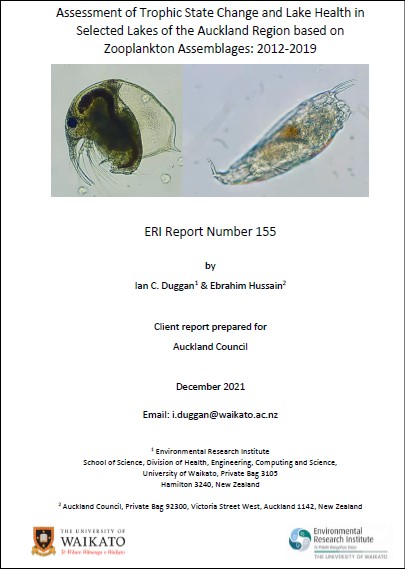Assessment of trophic state change and lake health in selected lakes of the Auckland region
Author:
Ian C. Duggan, Ebrahim HussainSource:
Environmental Research Institute, University of WaikatoPublication date:
2021Topics:
EnvironmentAssessment of trophic state change and lake health in selected lakes of the Auckland region based on zooplankton assemblages: 2012-2019
Executive summary
This report provides an assessment of eight natural lakes in the Auckland region, from zooplankton samples collected between 2012 and late 2019 at a frequency of six to eight samples per year. From these samples, the lakes have been assessed to establish their trophic state, the proportion of non-native zooplankton species, and the proportion of crustacean zooplankton relative to rotifers.
Inferred trophic states of the lakes based on zooplankton composition has been generally ranked in a similar manner over time; of the lakes sampled over the entire period, Lake Tomarata typically had the best inferred water quality (generally as mesotrophic, though late in the study it sat near the eutrophic boundary). The median Trophic Level Index (TLI) based on zooplankton for this lake was 3.5 between 2015 and 2019. Lake Whatihua, only sampled from late-2017, was also assessed to contain species typical of mesotrophic conditions (median TLI = 3.4). For the remaining lakes, median TLI values based on zooplankton composition between 2015 and 2019 were; Rototoa 3.5 (mesotrophic), Wainamu 4.0, Pupuke 4.3 (both eutrophic) and Kuwakatai 5.2 (supertrophic; sampling ceased in August 2017). Lakes Kereta and Spectacle were not assessed during the 2015-2019 time period.
Lake Pupuke rapidly declined in water quality in 2019, to have hypertrophic assessments at the end of the study; this is consistent with reported high chlorophyll a concentrations at this time. Lake Tomarata was assessed to have declining water quality based on zooplankton composition, in common with traditional TLI assessments. However, this lake was assessed to have higher water quality overall, and to diverge in assessments by 1.2 TLI units; this may in part be due to elevated TN concentrations in this lake, not reflected in concentrations of TP or chlorophyll a, which may unduly affect traditional TLI assessments for this lake. The other long-term lakes, Waimanu, Pupuke and Rototoa, all has assessments within 0.5 TLI units when comparing the traditional and rotifer inferred TLI systems.
The proportion of non-native species and the proportion of crustacean zooplankton relative to rotifers both showed promise as monitoring tools for the Auckland lakes. Two non-native species were recorded in the lakes, with various levels of dominance. Daphnia galeata was recorded in all of the monitored lakes, while Skistopiaptomus pallidus was recorded in Lake Kereta only. For the proportions of non-native species, Lake Tomarata was least affected, with samples comprising 4.9% non-native species on average. Data from 2012 and 2013 indicated that the overall relative abundances of the calanoid copepod Skistodiaptomus pallidus in Lake Kereta were far lower than they were in the year’s immediately following invasion in late 2008. No new non-native species were recognised in the monitored lakes during this survey, although an unusual occurrence of the copepod Boeckella propinqua was recorded in Lake Whatihua; this species has otherwise been found from natural lakes only in the central North Island, although has been recorded previously in Auckland dams.
On average, larger crustaceans dominated over the smaller rotifers in all of the Auckland lakes monitored. Lake Rototoa was the least crustacean dominated (53%), followed by lakes Tomarata (58%), Kereta (68%), Spectacle (78%), Whatihua (79%), Wainamu (81%), Pupuke (88%), and Kuwakatai (95%) was the most crustacean dominated. Lake Wainamu appears to have reduced proportions of crustaceans between 2018 and 2019 relative to the 2012 to 2017 period, which may indicate this lake is undergoing a change in its trophic ecology; control of pest fish ceased in this lake in 2015, including of European perch (Perca fluviatilis), which may be reducing the importance of larger, more visible crustaceans.
Environmental Research Institute report 155. University of Waikato, December 2021
See also
